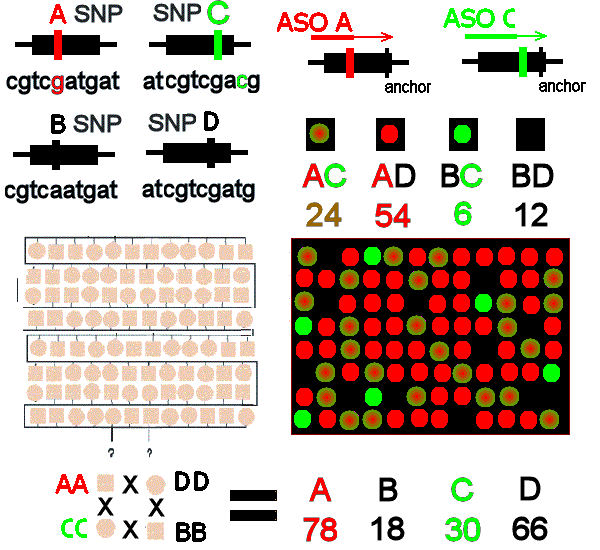

rtPCR-ASO test for diploid loci:
relative success of pairwise crosses
[click here for a blue/yellow version]
DNA
re-sequencing of a series of fish identifies two Single Nucleotide
Polymorphism (SNP) variants at two diploid nuclear loci: A vs B and C
vs. D (top, left). Two PCR primers
are constructed that are specific for SNP
alleles A & C,
respectively.
These allele-specific
oligonucleotides (ASOs) are paired with an anchor primer for a
downstream DNA sequence (top, right). Progress of the PCR is monitored in "real time", and a successful reaction
indicates the
presence of the corresponding SNP allele. Multiplex rtPCR detection is able to follow the separate A & C fluorescent experimental signals simultaneously, as well as a third control fluorescence (not shown).
Biodiversity application:
An
aquaculturist wishes to know the relative reproductive performance of two
pairs of male and female cod, drawn from different stocks. In one pair, the male fish is homozygous for the A SNP (AA) and the female fish homozygous for the C SNP (CC) The other pair is chosen to be homozygous for the alternative allele at each locus, BB and DD respectively. Four crosses are possible, each of which will produce a distinct heterozygote: AC, AD, BC, or BD.
The four fish are placed in a tank and allowed to breed at random:
fertilized eggs are collected and raised to post-hatching larvae
(bottom left). DNA is extracted from each of 96 larvae, and the A & C multiplex rtPCR-ASO tests are run on each sample in a
96-well plate format (bottom, right).
Each heterozygote has a distinct fluorescence: the detector recognizes simultaneous success of the reactions in AC heterozygotes. The numbers of larvae with each genotype, and the allelic contribution of each parent, are determined automatically. Here, the AA male is most successful, as is the DD female: note that these fish are from separate populations.
This multiplex experimental design allows efficient, "one-tube" monitoring of experiments involving diploid loci. The multiplex reaction does not require ASO primers for the B & D SNPs, if only two alleles exist at each SNP position, and the control ASO rules out "false negatives" for these SNPs.